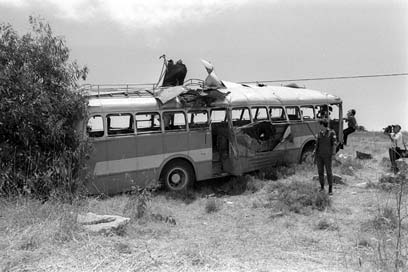


Operation Litani was a six-day military campaign carried out by Israel in 1978. The operation was meant as retaliatory action to a series of terror attacks on Israeli targets, emanating form Lebanon.
The Coastal Road massacre
The catalyst for the operation is believed to be a Palestinian terror attack which took place on Saturday, March 11, 1978: The day saw an 11-man terror cell infiltrate Israel via the sea, coming up on the shores of Kibbutz Ma'agan Michael. The cell proceeded take control of a bus traveling on Highway 1, connecting Tel Aviv and Haifa, and hold its passengers hostage.
The terrorists made the bus driver turn towards Tel Aviv, while they began handcuffing all the male passengers, shooting and hurling grenades at passing cars. Four drivers were killed. While en route to Tel Aviv, the hijackers were able to seize a second bus, forcing its passengers to board their bus.

The hijacked bus (Photo: GPO Archives)
Israeli security forces were finally able to stop the bus near Herzliya and a gun fight immediately ensued. Some of the terrorists burst out of the bus, firing at the Israeli forces, while others remained on it, shooting the passengers who were trying to escape. The terrorists eventually blow up the bus, killing 35 people and injuring 71.
Incursion
The Coastal Road massacre prompted then-Prime Minister Menachem Begin to order the Israeli Defense Forces to mount an attack on the terror groups hiding in south Lebanon. Operation Litani began on March 15, 1978, with what was considered to be an unprecedented air strike on terror hubs in the area. March 16 saw IDF ground troops venture deep into Lebanon, taking over the area between the international borderline and the Litani River, stopping just short of the Lebanese city of Tyre.
The forces speared across four sectors in Lebanon, wishing to create territorial continuity between the three Christian enclaves in Lebanon's south, and thereby creating a military "belt" between Israel and Lebanon. The area would later be known as the Israeli Security Zone.

IDF forces patrolling a south Lebanon village (Photo: GPO)
The majority of terror operatives fled the area during the first hours of the operation, but still, 300 of them were killed and the IDF obliterated all of the terror bases in the area. Nevertheless, terror groups shelled the Israeli communities adjacent to the northern border with heavy artillery fire throughout the operation.
The international community condemned the toll the operation took on the civilian population in southern Lebanon and on March 19, 1978 the UN Security Council passed Resolution 425 and Resolution 426, calling for the withdrawal of Israeli forces from Lebanon. Three days later, then-Defense Minister Ezer Weizman ordered the IDF to pull its forces out of Lebanon.
As IDF forces were pulling out of the area, Christian military commander Major Saad Haddad's forces – which would later emerge as the South Lebanon Army – took over a 15-mile stretch of land near the border.
The UN the created the United Nations Interim Force in Lebanon (UNIFIL) to enforce the resolutions. UNIFIL forces arrived in Lebanon on 23 March 1978, setting up headquarters in Naqoura.
Israel lost 15 combatants in the operation.














